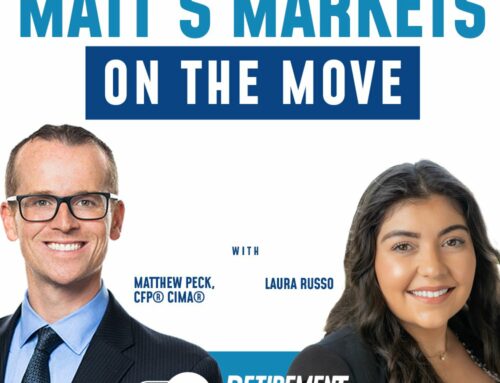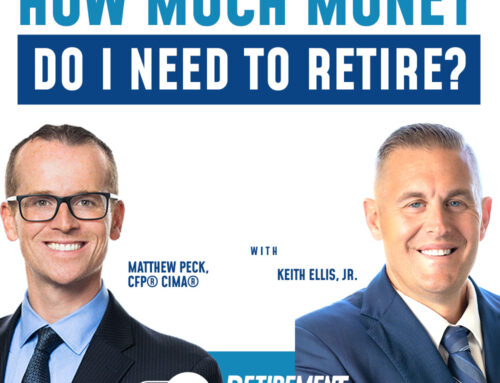At SHP Financial, we provide income, investment, tax, health care, and estate planning and help build effective portfolios. Today’s podcast is all about annuities. When they might make sense for you and when they wouldn’t.
Annuities are a big buzzword lately. Some advisors love them, and others steer clear of recommending them. So we’ve written a Guide to Annuities and made it a free download on our website to improve your knowledge and comfort level of them.
With that in mind, we’re joined by Joe Anderson. Joe’s been a financial advisor at SHP since 2015 and is very well versed on the pros and cons of annuities. We dig into how annuities have become such a controversial investment tool, how to determine if annuities could be a good fit for you, and how to find the right products for your portfolio.
In this podcast discussion, you’ll learn:
- Why some financial advisors only sell annuities and why others rarely ever recommend them.
- The four major types of annuities and how they’re typically used.
- The potential benefits–and major downsides–of using annuities.
Inspiring Quotes
- “If you’re sitting in front of a financial advisor who uses insurance or annuities, that may be the only thing that they can do for you.” – Joe Anderson
Interview Resources
- Joe Anderson on LinkedIn
- SHP Financial Guide to Annuities
Derek Gregoire: Welcome, everyone to another edition of the SHP Retirement Road Map podcast, brought to you, of course, by SHP Financial. I’m Derek Gregoire, joined by one of our advisors who’s been here for quite a few years, Joe Anderson. Welcome, Joe.
Joe Anderson: Thank you, Derek. I appreciate it. Excited to be here.
Derek Gregoire: How many years you’ve been here? Because I always mess that up.
Joe Anderson: I will be eight years in November.
Derek Gregoire: Eight?
Joe Anderson: Eight years.
Derek Gregoire: Oh, my gosh.
Joe Anderson: Yeah, 2015.
Derek Gregoire: I didn’t realize it was that long. Time flies when you’re having fun.
Joe Anderson: You’re getting old and I’m getting old.
Derek Gregoire: I know, right? No kidding. And I always thought, I was like, oh, we started the company at 23. I always felt like that young guy. And now, I’m 43. I’m like, all right, let’s not– early on, I’d have a couple people that would say, “Oh, your planning looks great, but I just can’t get over your age.”
Joe Anderson: Yeah, yeah. I have a client that jokes me all the time. I used to get that objection occasionally upfront.
Derek Gregoire: I never get it, by the way, anymore.
Joe Anderson: But whenever I got that objection, to be honest with you, the client, what he said to me really stuck with me where there’s really two people that you do want younger than you that you work with professionally, and that’s your doctor and your financial advisor, because they’re going to be there when you need them the most, obviously, that tail end to your life.
Derek Gregoire: Yeah, one of my clients is a doctor though, and he’s like, “What the heck? Why did you throw me under the bus for?”
Joe Anderson: Yeah. That’s too funny.
Derek Gregoire: But today’s show is a little bit different. It’s very particular, which we don’t usually like to do because we’re very holistic and when we do the planning, we do here at SHP Financial. And for all of you who listen to us and work with us, no, we provide full service from income, investments, taxes, health care, estate planning. We try to coordinate all that together for the folks you work with.
Over the years, there’s different tools within an investment portfolio from stocks, bonds, mutual funds, CDs, checking, annuities, real estate. So, it’s like there’s only so many choices you can choose from. And the good advisors are using those tools to build the best plan for the goals of the folks that he’s working with. Just like if you’re working with tools, actual tools, you’re going to use a hammer to put a nail in, but you’re not going to use a hammer to wash a window. Pretty common sense. So, we’re talking this, a Guide to Annuities. We presented a booklet that we have. And we’ll talk about how to get it. You can get it at our office. You can download it online at SHPFinancial.com, but we’ll go more into that.
And the reason we created that is because that’s a big buzzword in the industry. The word annuity sometimes people hear it and they love it. Sometimes, people hear it and they say never. Sometimes, an advisor hears it and says that’s the best thing. Sometimes, an advisor hears it and says it’s the worst thing. In our opinion, it’s just a tool. And if it fits, if there’s a certain situation where it makes sense, we’re going to use it. I personally own some myself, to be honest with you, and I’ve seen some that I would never recommend to anyone under any circumstance. So, it’s like saying, don’t buy a car because you had a bad experience with one car. There could be some good ones out there. So, just a general overview of the word annuity, Joe, because I know you hear the same thing.
Joe Anderson: Yeah, yeah. I mean, honestly, you hit the nail on the head where it’s just a tool, right? It may make sense for certain clients. It may not make sense for certain clients, but it isn’t just that blanket statement. Most people view it like annuity just means one thing. And what will take you through a lot today is there are a lot of different types. As Derek said, some of them can be okay. He even owned some of them himself. But there’s a lot of them that you definitely, absolutely want to steer clear of. A lot of variables within annuities that you need to be conscious of as you enter those pieces because I at least can vouch for this on my end, but I’d imagine you see it too, Derek, where clients come in, especially when they have a certain type of annuity product, they don’t even know what they own. They were told these flashy sales pitch-ey type pieces up front and then it underperforms what they were anticipating and they weren’t really even familiar with what they actually have.
Derek Gregoire: I find in the industry, I mean you have a certain advisor who might say they’re advisor, but that’s all they can sell their insurance license. So they can either sell life insurance or annuities. And so, no matter what you are, who you look like, if you only have annuities to sell, that’s how you’re going to be pushed. I’m not saying everyone’s like this because I know some, even people in that field that do a good job of following up and so forth. But some of those advisors can tend to sell, get a commission, and they never see that person again. They already get paid, right?
Joe Anderson: It’s pretty wild where I’ll hear even stories of a seminar that an “advisor” put on and he’s pitching an annuity product and showing them illustrations in the seminar. He doesn’t know anything about you, but he’s already trying to jam you into a set strategy or a bucket. That should be a red flag up front. And what Derek said is really important to be aware of too, is that if you’re sitting in front of a financial advisor who uses insurance or annuities, that may be the only thing that they can do for you. You want to make sure that they have all those tools in their tool belt. They don’t want to just have a belt full of hammers when you might need a screwdriver or drill or a saw.
Derek Gregoire: Exactly. So, on the other end, like I was saying, you have some advisors that say, “Nope,” they’re almost very proud. We don’t touch annuities. We would never sell an annuity, but that limits some potential good options in certain situations. And to me, I know the true fiduciary definition is doing what’s right for your clients above your own. But you think like even having this option in your toolbox makes sense under any situation for various clients who are looking to either generate income or reduce volatility and so forth.
So, in the game of Wall Street, you have some people who just sell annuities and then some advisors who just despise annuities. And we’re trying to be– we don’t say they’re good or bad because it depends on the situation. Is it good or bad? Maybe for someone it’s bad, maybe for another client it’s good.
Joe Anderson: Yeah. I mean, actually, you tell a story in seminars about being in college during when the Twin Towers were hit and the market crashing, your advisor that you worked for not answering those phone calls on that day because the market was falling. We never shy away from answering phone calls because of market performance, because we have all these tools that allow us to control that volatility, to ensure that the client’s plan works, whether the market’s working or not. And most people come in and they have a portfolio, they don’t have a plan.
Derek Gregoire: Yeah. And now, we’re being specific in terms of the Guide to Annuities brought to you or presented by the SHP advisors. In this guide, there’s a lot of good information. But let’s go through the basics of the four major types of annuities. So, what do you want to start with?
Joe Anderson: We can start with immediate. I think immediate, it’s fairly similar to understand if you have a pension or you’ve ever run into someone with a pension. There’s usually that lump sum value, right? That’s essentially what an immediate annuity is. As you take a lump sum value of your money position in this annuity, no longer do you have access to that money any longer. So, it’s not a flexible tool, that’s for sure, but it immediately starts paying out an income either for a set period of time or for the rest of the client’s life.
But in my opinion, not only obviously are they not super flexible, but there can be some drawbacks to be conscious of in the immediate annuity space. You want to ensure that there are beneficiaries listed, a lot that will provide you the best payout. No beneficiaries pass away early, insurance company wins, and you also want to make sure that the income streams you create can keep pace with inflation. I don’t see that happen often and immediate.
Derek Gregoire: A lot of people think, and we don’t do a lot of immediates, to be honest. Very rarely comes up. But a lot of people think of the word annuity is you give the company money, you get a check every month. And if you die tomorrow, it’s gone. And that is a type of an immediate annuity, but that definitely doesn’t speak for all annuities. And I should probably mention this 20 times, but do not go buying any of this stuff or looking into any of this stuff without a recommendation from a true fiduciary, be a good adviser that understand your situation, obviously.
So, a number one immediate annuity, you give the company money, insurance company, they pay you back a check every month for a period of time or your life. So, what’s option 2? Or not option, but what’s another type of annuity?
Joe Anderson: So, the second kind of annuity that you see, I feel like we see these maybe more often than most are variable annuities. So, variable annuities are in the market. So, out of the nature of their name, they can fluctuate up or down in value. But simultaneously, what we found, at least with variable annuities, we don’t leverage these tools too typically because they’re riddled with fees. Quite often, individuals pay somewhere between maybe 2% up to 5% underlying in fees. I had someone sit in front of me that paid over $30,000 a year. And just fees and a variable annuity, they had no idea.
Derek Gregoire: It’s crazy.
Joe Anderson: I ask them, I go, “Would you write your advisor a check for that $30,000? He provided you enough value this year.” And he said, “Absolutely not.” And I said, “Then, well, you shouldn’t be paying the annuity company those types of fees either.” And with those pieces as well, that flexibility, again, they’re just very rigid in nature. They kind of structure them. So, you’re penalized pretty substantially to leave early. And there’s usually a value that is almost a phantom value that really isn’t all yours unless you draw from it over a very prolonged period. And that’s usually how they’re sold as that’s what the advisor “worked” with.
Derek Gregoire: A lot of people think I’m getting like 7% a year in there.
Joe Anderson: That’s what I hear often.
Derek Gregoire: And I’m like, “Well, you’re paying 4% to get 7%. And that 7% account is only if you take it as an income stream.” So, I will say variable annuities do give you some upside of the market. You still participate in the downside and at least, if everything goes bad, you have some sort of income value that you can draw something off. This isn’t designed to give recommendations, but usually, I haven’t seen a ton that I love most importantly because to me, if you want a variable return you can go into the general market and save yourself multiple thousands of dollars a year in fees. And if you want an income-based, you can go to the fixed side and receive something a lot cheaper as well. So, you have immediate. We have variable. What’s the third kind?
Joe Anderson: The third is just called fixed. So, the most similar tool that you could compare it to is maybe like a CD where it’s a set period of time where you’re tying the funds up for a set guaranteed interest rate, but they are tied up for that time frame. There’s a penalty to leave, so it may not be the most attractive tool. Interest rates prior to this year were peanuts, so they weren’t tools really leveraging almost at all prior to this year. But you can get some pretty attractive guaranteed rates in a fixed– it’s a tool. So, it’s not our favorite necessarily, but it’s not a bad tool either.
Derek Gregoire: Yeah, it’s similar to a CD. Obviously, it’s not a CD. Totally different. CDs are FDIC insured. You obviously want to be with a good insurance company if you’re going to go with a fixed annuity. But obviously, the rates change, but you could have this year get a five-year and the five-and-a-half percent range maybe where you had a locked-in return, no annual fees. You maybe can take out the interest or 10% a year, definitely could be rigid in terms of obviously a CD has more flexibility, it’s FDIC insured, but it’s a good comparison, think of a fixed rate of return for a fixed period of time. And then you can take your money and do what you want with it.
Joe Anderson: Yeah, yeah. It’s important with any annuity just to be aware. The fees are super important, but how much access do you have to that money during the annuity maturity timeframe? So, it’s just something to be very conscious of.
Derek Gregoire: Yeah. And as you mentioned, we have this guide. We’re trying to make it simple. This is a very small part of our process, but some people get very confused on annuities. It can be a confusing area if you’re not a professional. We just want to go through kind of the good, bad, ugly and just give everyone something to read through to understand how they work. Because again, they don’t work for everyone. But for some people, it could be a fit within an overall plan. If you’re a client and you want the guide, you just visit one of our offices and grab one, or if not, you can go to our website SHPFinancial.com and download it right from there.
So, we’ve gone through three of the four major types of annuities. We’ve used immediate annuities, which provide immediate income. We looked at variable annuities which are based on the market, usually tend to have higher fees. Fixed annuities usually have very little to no annual fees. You get a fixed return for a period of time. And then the fourth one, Joe, I believe is fixed index that you’re going to go through.
Joe Anderson: Yep. So, fixed indexed annuities, they kind of pick and choose various benefits of the previous three that we touched on. Know that in the fixed indexed base, not all are created equal by any stretch. There’s only a few that even fit in the space that we’re actually comfortable with for certain clients.
But first word, fixed, principal protected, so those dollars are protected from market risk when those dollars are positioned there. So, for more conservative clients, it can make sense for a piece of their dollars. But the word indexed is tied directly to the stock market, similar to a variable on that front. So, you get to perform positively in positive market years. They just typically don’t provide you all of the upside of the market because of their downside protection.
Derek Gregoire: So, in today’s market, you might get 10%, 11% of the upside of the S&P in a good year. But if it goes up 30, you’re still getting 10 or 11. If it goes up 8, you get 8. If it goes down 30, you get 0.
Joe Anderson: Exactly.
Derek Gregoire: That’s a kind of a good way to look at the base component of it.
Joe Anderson: Yeah, it’s a really powerful and attractive compound interest effect too, because you earn 5% the first year and then 5% the next. It’s 5% of a larger number in that second year. And for a lot of individuals who we implemented this strategy years back and they locked in their interest prior to the volatility last year, it’s funny, these pieces can be our client’s favorite tools if they have them in certain years, and other years, their least favorite tool because it only got 6% when the market did 15.
Derek Gregoire: Exactly.
Joe Anderson: But it’s all about selecting the tools and the blend that makes the most sense to you to give you that confidence. But even with those fixed annuities, too, not only can they tie them to the market, like Derek mentioned, but some of them still do offer attractive fixed rates, like a fixed CD, if you like having a set interest rate but also want to dabble in the market. They give you some flexibility there.
Derek Gregoire: Yeah. So, you can put some into a fixed debt a good percentage and some into an index at a certain percentage and blend it together. But the main tool, and you say, when would that come into play? When would something like that come into play? Well, if you’ve seen our charts in terms of how we allocate money, safety, income, growth, right? We always like to keep money in a safe bucket.
Let’s say you’re retiring or retired, you want enough money in a safe bucket that you can draw from for emergencies, rainy days, the roof leaks, that could be like checking account savings, money market. You’re not going to break the bank, but you’re not going to worry about. It’s liquid and it’s available.
I’m going to skip over income for a second and go to growth bucket. The growth bucket is your money, and the majority of the funds that we manage at SHP, between Fidelity and Schwab, are in the growth bucket. That’s the majority of our businesses, our portfolios that we manage for our clients. That piece of the puzzle, though, especially based on the growth within the portfolio, you need to have time. And if you’re retired, a lot of people say, “Well, I don’t have time to ride the ups and downs.”
Joe Anderson: Exactly.
Derek Gregoire: But if you have enough in the income bucket, which is the middle one, so safety, income, growth, income bucket are things like CDs, treasuries, fixed annuities, bonds, things that have little to no market risk. And why do we want to fill that puzzle? Why do we want to fill that piece of the pie in that bucket? Well, if you have $2 million and you need to pull out $70,000 a year, and if we put $700,000 between those categories, bonds– I’m making an example, bonds, CDs, Treasuries, annuities, conservative-type investments. if we’re drawing from that bucket, we can get many, many years of withdrawals, as if you were still working because with Social Security pension in this bucket of money that we can pull from with little to no market risk, that allows the growth money what it needs is time. We always need time in the market.
And so, even if you’re retired, we can almost make it like you’re still working because you have your paychecks coming from Social Security pension and your income assets. So, we can still allow the growth assets to grow. And this whole little thing we talk about, that’s just part of an income, an investment plan. But the whole picture at SHP is obviously not just having a portfolio, but a plan that looks at– like yesterday, we had a client review. And we were talking about their estate plan. We talked about long-term care, Medicare. We’ve already done some Roth conversions. We’re looking at maxing out tax brackets.
So, I think the main thing we try to do is micromanage every little area of retirement. But the annuities always seem to be like a hot-button topic, people have different opinions on them. So at the end of the day, it’s like, is annuity right for you? We don’t know. But this guide was created just to give people a little bit more understanding of how they work, the different types. You said, there’s four major types of immediate, fixed, variable, and indexed, and each type has good and bad ones almost within them. So, I think, things are kind of going through the different types. Anything else you’d like to mention that you can think of before we part ways there?
Joe Anderson: Yeah, I think you mentioned a few things that I think are just important to understand about just annuities in general. Why is this tool something that I would ever implement into my own financial plan? And you said, the manner of time, building in time to the market, that’s one of the most important layers in general, creating pieces that you can draw from in down markets, not selling low at the wrong time, compounding that loss.
If you play for that scenario, you said, or a client has $2 million and they need $70,000 a year, they lost 15% last year, they lost 300 grand. And they pulled out another 70 on top of that. That is years of retirement income they lost in one bad year. So, if you can create your self-confidence to have those layers to draw off of and also get math to work in your favor if that same client put $500,000 into an annuity and they still lost that 15%, they didn’t lose 15% of that $500,000, they got math to work in their favor. Math hurts a lot more as you gain and accumulate your wealth.
Derek Gregoire: And where their losses came from, they’re not selling out of.
Joe Anderson: Right, exactly.
Derek Gregoire: They have time to recover. If you’re selling out while it’s going down, that’s very hard to recover.
Joe Anderson: Well, I mean, that’s how I’m using, for clients that have them now and they don’t need the income yet, you can pull money from the annuity, put it back into the market low right now. What a great opportunity that is. And you can even layer in specific fixed indexed annuities that provide you lifetime income, like an immediate annuity, but help you avoid those drawbacks of money not going to beneficiaries or being concerned that it’s not going to grow with inflation. You just have to know what strategy you’re implementing. And there’s a lot of misconceptions on annuities in general.
Derek Gregoire: 100%. One thing I would say is like, and I should’ve mentioned this earlier, but one of the downsides, if someone wants to implement that is you’re limited to 10% per year usually. So, it’s that there are downsides. Like, for the benefits of certain accounts, there are downsides. Like, full disclosure, my wife and I got a couple this year and we divided up some money into a fixed bucket at around 5% and some money went into the S&P with a cap of somewhere between 10 and 13, whatever, I forget what it was.
But even at 43, I wanted some of my assets to be conservative. Now, I can’t really touch those assets for a few years, but that’s okay because I have other assets that I have available if we need them in the meantime. So, really, when it comes to annuities or anything, it’s all about the plan that’s best for you. So, the last thing we want anyone listening to do is to take this guide and, oh, I need to buy an annuity. Nope, definitely not the case. We’re just trying to educate on them because we get so many questions on them.
So, before we go, like I said, we have this guide, SHP Guide to Annuities, just to try to create some value like we do around all the things we do here. And just to give people some ways to learn more about different options for their retirement, for their accounts, and to learn more about things such as annuities. So, if you want to get the guide, one way is if you have an appointment with our office, you want to make an appointment, you can do that. Our website is SHPFinancial.com.
On the website, you can also go to the library tab and we have an area called Books & Useful Guides. There’ll be a ton of cool guides, information on there, but one of them is the SHP Guide to Annuities that we were talking about today. So, thanks, Joe, for joining us.
Joe Anderson: Thanks, Derek.
Derek Gregoire: We appreciate it. And hopefully, you found this educational, and we’ll talk to you all real soon. Have a great one.
Joe Anderson: Take care.






